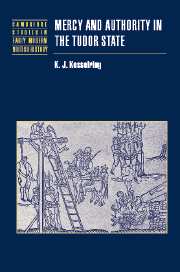Book contents
- Frontmatter
- Contents
- Acknowledgments
- Abbreviations and conventions
- 1 Introduction: mercy and the state
- 2 Changing approaches to punishment and mitigation
- 3 Changing approaches to the pardon
- 4 Patronage, petitions, and the motives for mercy
- 5 Public performances of pardon
- 6 Protest and pardons
- 7 Conclusion
- Appendix I Sources
- Appendix II Benefit of the belly
- Bibliography
- Index
- Titles in the series
7 - Conclusion
Published online by Cambridge University Press: 05 July 2009
- Frontmatter
- Contents
- Acknowledgments
- Abbreviations and conventions
- 1 Introduction: mercy and the state
- 2 Changing approaches to punishment and mitigation
- 3 Changing approaches to the pardon
- 4 Patronage, petitions, and the motives for mercy
- 5 Public performances of pardon
- 6 Protest and pardons
- 7 Conclusion
- Appendix I Sources
- Appendix II Benefit of the belly
- Bibliography
- Index
- Titles in the series
Summary
Mercy and truth preserve the King, and by clemency is his Throne strengthened.
Proverbs 20:28The bloody nature of Tudor justice is self-evident. Prisoners literally rotted in dank gaols; postmen traveled the country delivering traitors' severed limbs to selected towns; young boys burned at the stake for heresy; servants who killed their masters with poison met their ends in vats of boiling water. The number of executions remains unknown, but one historian has estimated that in later Elizabethan England the courts sent, on average, between 600 and 700 people to their deaths every year. In 1577, London's Recorder William Fleetwood reported to Lord Burghley that “at the last sessions there were executed eighteen at Tyburn … It was the quietest sessions that ever I was at.” Yet, many people in early modern society spoke of their sovereigns and the enforcement of their law as clement. This study began as an attempt to explain this seeming contradiction. It has tried to clarify how people in Tudor England understood the relationship between mercy and justice, and how this understanding shaped the experience of law and authority. It has also endeavored to illuminate key aspects of a political culture specific to the sixteenth century while also contributing to larger debates about the nature of law and state power.
If seen not with a presentist gaze, but rather through the lenses offered by contemporary texts, pardons had an accepted place in early modern conceptions of justice and due punishment.
- Type
- Chapter
- Information
- Mercy and Authority in the Tudor State , pp. 200 - 208Publisher: Cambridge University PressPrint publication year: 2003



